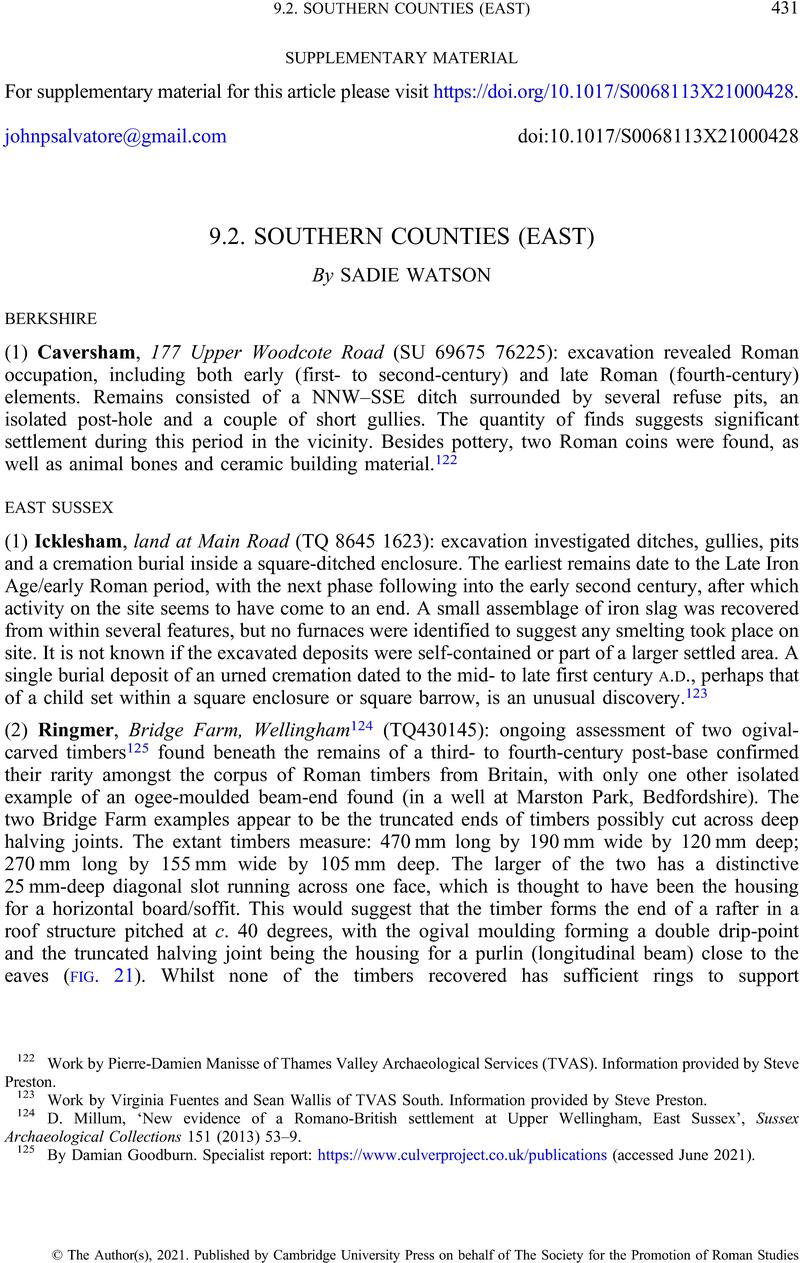No CrossRef data available.
Article contents
9.2. SOUTHERN COUNTIES (EAST)
Published online by Cambridge University Press: 10 December 2021
Abstract

- Type
- Roman Britain in 2020
- Information
- Copyright
- Copyright © The Author(s), 2021. Published by Cambridge University Press on behalf of The Society for the Promotion of Roman Studies
References
122 Work by Pierre-Damien Manisse of Thames Valley Archaeological Services (TVAS). Information provided by Steve Preston.
123 Work by Virginia Fuentes and Sean Wallis of TVAS South. Information provided by Steve Preston.
124 Millum, D., ‘New evidence of a Romano-British settlement at Upper Wellingham, East Sussex’, Sussex Archaeological Collections 151 (2013) 53–9Google Scholar.
125 By Damian Goodburn. Specialist report: https://www.culverproject.co.uk/publications (accessed June 2021).
126 Work by the Culver Archaeological Project, directed by R. Wallace and D. Millum, who sent the information. For investigations undertaken between 2011 and 2017, see D. Millum, Bridge Farm: The Excavation of a Romano-British Riverside Settlement: Part 1, 2011–2017 (2018) https://www.culverproject.co.uk/publications (accessed June 2021).
127 Work by Guy Seddon of Pre-Construct Archaeology Ltd for Orion Heritage on behalf of Croudace Homes Ltd. Information provided by M. Małecka.
128 Following earlier evaluation. Work by Guy Seddon of Pre-Construct Archaeology Ltd for Orion Heritage on behalf of Croudace Homes Ltd. Information provided by M. Małecka.
129 Bushe-Fox, J.P., Fourth Report on the Excavation at the Roman Fort at Richborough, Kent, Reports of the Research Committee of the Society of Antiquaries of London 16 (1949) 11–13Google Scholar.
130 Excavation for the English Heritage Trust carried out by the Historic England Archaeological Projects Team, directed by Tony Wilmott. Information provided by M. Jecock.
131 Work by Odile Rouard and Kyle Beaverstock of TVAS South, following a geophysical (magnetometer) survey in September 2020. Information provided by Steve Preston.
132 BM reference: 2019 T581. Recovered using a metal-detector from the topsoil and spoil heap of a single evaluation trench and identified as a possible dispersed hoard during post-excavation analysis. The same trench also produced a small group of pottery dated to c. a.d. 270–350. Three fourth-century nummi were also recovered from the trench, but are not thought to have formed part of the hoard. Information provided by Trista Clifford.
133 Work by Dominic McAtominey and Maisie Marshall of Pre-Construct Archaeology Ltd for RPS Consulting. Information provided by M. Małecka.
134 BM reference: 2019 T1136; PAS reference: SUSS-93EC49. Disposition: to be determined. Information provided by Richard Abdy.


